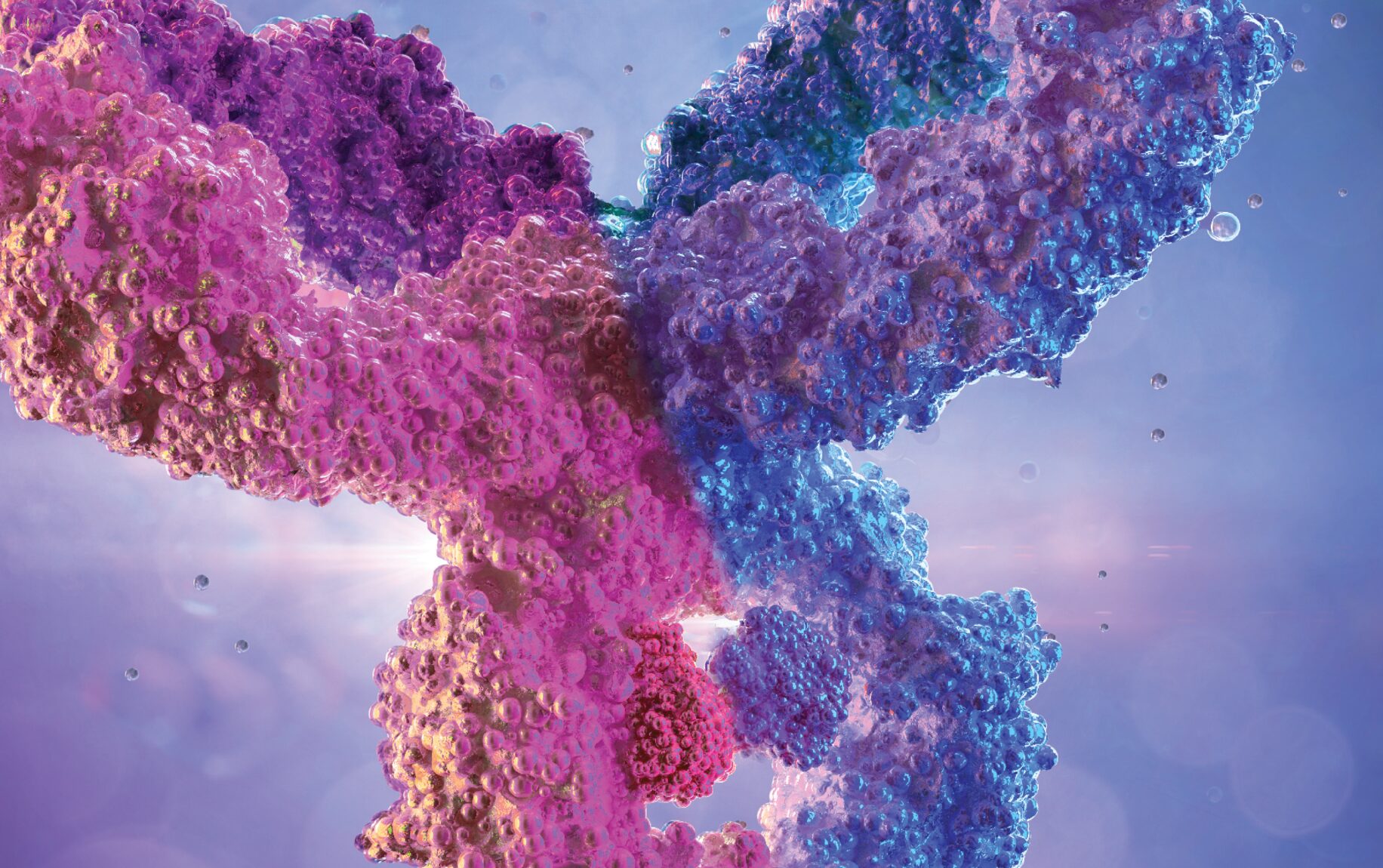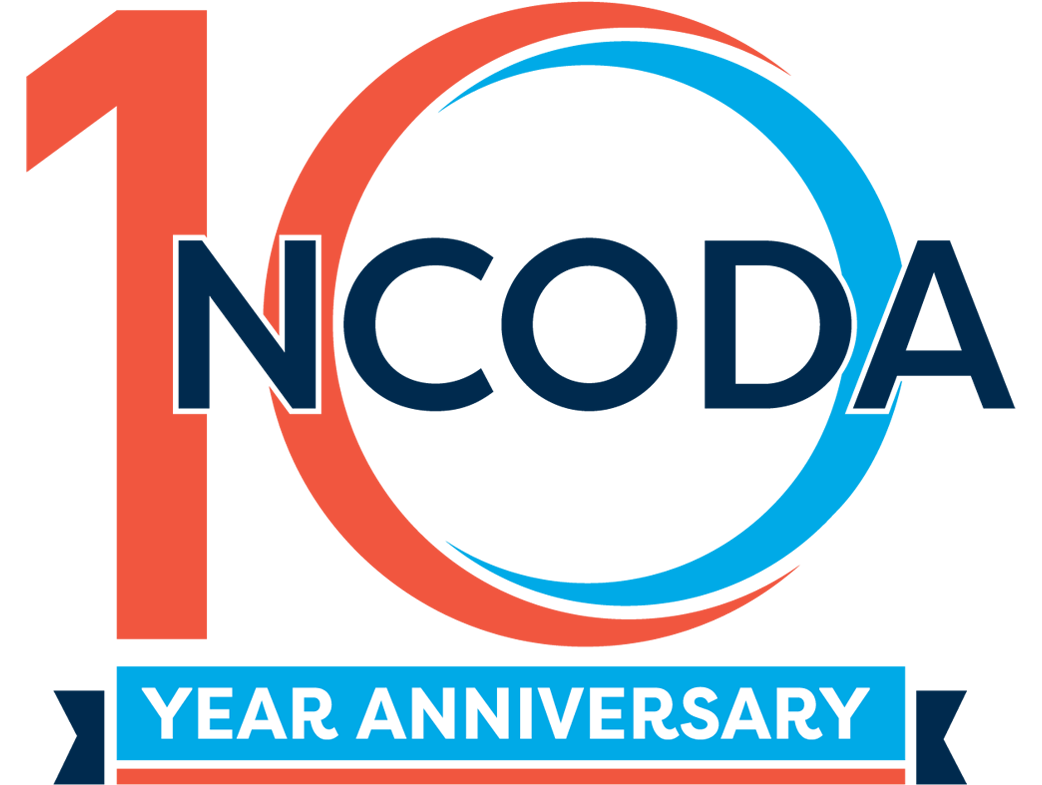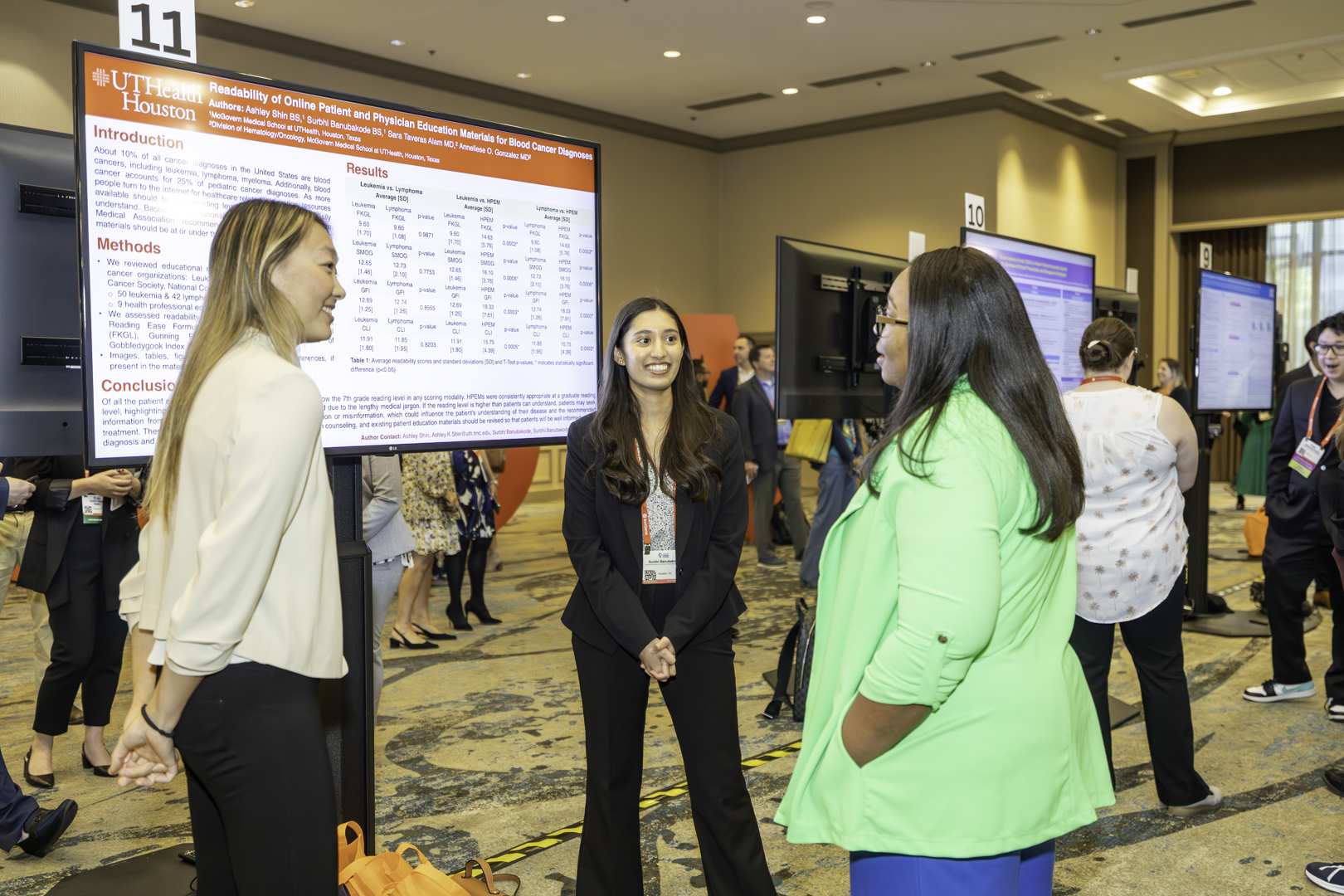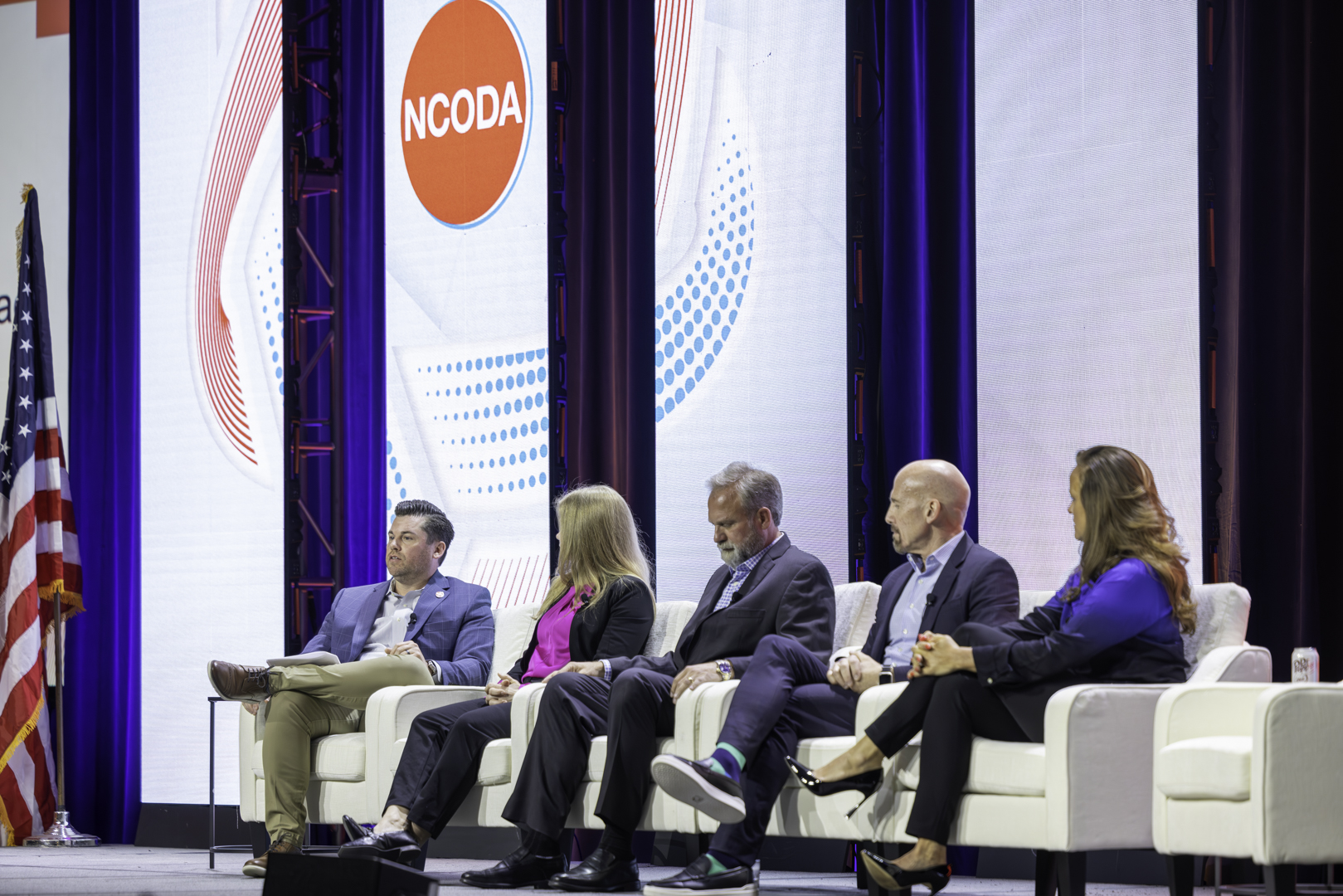2026 International Spring Forum
April 15, 2026 | 12:00 PM EST
OncolyticsToday: The Bispecific Antibody Revolution
Published Date: April 1, 2024

THE EVOLVING LANDSCAPE OF ONCOLOGY
By Lotanna Ezeofor, PharmDc & Kelly Brunk, PharmD, BCOP
T cell-engaging bispecific antibodies (BsAbs) have emerged as a significant advancement in cancer immunotherapy, transforming the treatment landscape for patients with certain hematologic malignancies and solid tumors. These therapies leverage the body’s immune system to target and destroy cancer cells with high specificity,1 providing new options for patients who may not respond to traditional treatments. BsAbs are primarily approved for treating patients with relapsed or refractory cancers, but their use is anticipated to extend into earlier treatment stages, both as standalone therapies and in combination with other standard care regimens.
Given the rapid advancements in BsAb therapies and their growing importance in oncology, there is a need for an overview that not only examines their historical development and mechanisms of action but also compares their efficacy and safety with CAR-T therapies and evaluates the potential challenges and opportunities they present in clinical practice.
This article will also provide a detailed overview of the adverse effects associated with BsAbs and assess the current outlook for these therapies in cancer care. By addressing these topics, this review aims to equip healthcare professionals with a thorough understanding of BsAbs and their role in modern cancer treatment.
HISTORICAL CONTEXT
The first BsAb to receive U.S. Food and Drug Administration (FDA) approval was blinatumomab, which was approved for the treatment of relapsed or refractory (r/r) B-cell acute precursor lymphoblastic leukemia (BCP-ALL) in 2014.8 Recently, there has been a significant uptick in the approval of BsAbs, with eight new agents approved over the past three years. These include mosunetuzumab (2022) and epcoritamab (2024) for r/r follicular lymphoma (FL),9,10 glofitamab (2023) and epcoritamab (2023) for r/r diffuse large B-cell lymphoma (DLBCL),10,11 teclistamab (2022), talquetamab (2023) and elranatamab (2023) for r/r multiple myeloma (MM),12-14 tarlatamab (2024) for second line treatment and beyond (2L+) extensive stage small cell lung cancer (ES-SCLC),15 and tebentafusp (2022) for HLA-A*02-01 advanced uveal melanoma.16 Tables 1-3 (see Pages 58 to 60) provide profiles of the FDA-approved BsAbs as of August 15, 2024.
OVERVIEW OF BsAbs MECHANISM OF ACTION
BsAbs are a class of immunotherapeutic agents designed to redirect T cells against cancer cells,1 offering a novel mechanism of action across various malignancies. These molecules consist of two single-chain variable fragments linked together, with one binding to the CD3 receptor on T cells and the other targeting a specific antigen on cancer cells, such as CD20, CD19, BCMA, GPRC5D, DLL3, or gp100 peptide-HLA.1 This dual binding brings T cells close to cancer cells, activating T cells and inducing apoptosis through the release of cytotoxic granules.1,17 Additionally, the binding to CD3 triggers T-cell activation, proliferation and cytokine release, enhancing the immune response.
INDICATIONS AND APPLICATIONS
BsAbs have been approved by the FDA for the treatment of hematologic malignancies and solid tumors. Hematologic Malignancies: For adult with r/r MM who have undergone at least four previous lines of therapy, which include a proteasome inhibitor, an immunomodulatory agent and an anti- CD38 monoclonal antibody, teclistamab, talquetamab and elranatamab have received approval.12-14
Additionally, mosunetuzumab and epcoritamab are approved for treating adults with r/r FL following two or more lines of systemic therapy.9,10 Epcoritamab and glofitamab are also approved for adults with r/r DLBCL after two or more systemic therapies.10,11 Blinatumomab has been approved for treating CD19-positive BCP-ALL, including those in first or second complete remission with minimal residual disease (MRD) of 0.1% or greater, r/r CD19-positive BCP-ALL and CD19-positive Philadelphia chromosome-negative (Ph(-)) BCP-ALL during the consolidation phase of multiphase chemotherapy.
Solid Tumors: Tebentafusp is approved for treating adult patients who are HLA-A*02:01-positive with unresectable or metastatic uveal melanoma.16 Tarlatamab is indicated for adult patients with ES-SCLC whose disease has progressed on or after platinum-based chemotherapy. Dosing and Administration: BsAbs typically utilize a step-up dosing regimen during the initial doses,18 gradually increasing doses to mitigate severe adverse events like cytokine release syndrome (CRS).18
Administration methods vary depending on the product; some are administered intravenously (IV), while others are administered subcutaneously (SubQ).
Length of Therapy: The duration of treatment varies depending on the specific agent, ranging from a set period to indefinite use until disease progression or the onset of intolerable side effects.20
EFFICACY
BsAbs have shown significant efficacy across various cancers. Hematologic Malignancies: In r/r FL, epcoritamab and mosunetuzumab have achieved objective response rates (ORR) of about 80%, with complete response (CR) rates of approximately 60% and long durations of response.9,10,21 For r/r DLBCL, epcoritamab and glofitamab have demonstrated ORRs near 60%, with around 40% CR rates.10,11,22,23 In r/r MM, teclistamab, talquetamab and elranatamab have shown ORRs between 60% and 75%, with over half of the patients achieving a very good partial response (VGPR) or better.12-14,24-26
In leukemia, blinatumomab has proven effective for various indications. In frontline consolidation, alternating blinatumomab with chemotherapy improved overall survival compared to chemotherapy alone, reducing the risk of death from any cause by 58% in patients with MRD negativity.8 For patients with MRD+ BCP-ALL, single-agent blinatumomab achieved a complete MRD response in 81%, leading to longer relapse-free survival.8,27
In Ph(-) r/r BCP-ALL, blinatumomab nearly doubled median overall survival compared to standard chemotherapy and provided deep, durable remissions. Solid Tumors: In 2L+ ES-SCLC, tarlatamab demonstrated an ORR of 40%, a disease control rate (DCR) of 70%, a median duration of response (DoR) of 9.7 months and a median overall survival (OS) of 14.3 months.15,28 For the firstline treatment of HLA-A*02:01 uveal melanoma, tebentafusp achieved an ORR of 9%, a DCR of 46% and improved median OS by approximately six months (21.1 months vs. 16.9 months) compared to the investigator’s choice of pembrolizumab, ipilimumab or dacarbazine.16,29
SUPPORTIVE CARE CONSIDERATIONS
Supportive measures, including infection prevention, IV hydration and tumor lysis syndrome (TLS) prevention, are often recommended for patients receiving BsAbs.30-33 Prophylaxis for Pneumocystis jirovecii pneumonia (PJP) and herpes simplex virus (HSV)/ Varicella-Zoster Virus (VZV) is recommended for BsAbs targeting BCMA (teclistamab and elranatamab), GPCR5D (talquetamab) and CD20 (epcoritamab, mosunetuzumab and glofitamab).9-14
For these agents, routine screening for cytomegalovirus (CMV) might be appropriate depending on epidemiologic risks. For CD19-targeting blinatumomab, PJP and HSV/VZV prophylaxis can be considered. Note that anti-infective prophylaxis is not recommended for agents like tarlatamab or tebentafusp.
Intravenous hydration is recommended with some agents, particularly for patients with low volume status due to the risk of cytokine release syndrome. For example, with tarlatamab, 1 liter of normal saline should be infused over four to five hours immediately following the infusions during cycle 1. Per the package insert, prophylaxis for TLS using anti-hyperuricemics should be administered when starting treatment with glofitamab.11
OVERVIEW OF ADVERSE EFFECTS WITH BsAbs
Cytokine Release Syndrome (CRS): CRS is a common and serious adverse effect associated with BsAbs, resulting from the rapid activation of T cells and subsequent cytokine release.34 Symptoms range from mild flu-like symptoms, such as fever and fatigue, to severe issues like hypotension, hypoxia and multi-organ dysfunction.34,35 CRS severity can be graded by the uniform consensus grading system developed by the American Society for Transplantation and Cellular Therapy (ASTCT) (See TABLE 4).35
Preventive strategies, such as step-up dosing — gradually increasing initial doses to allow the immune system to adjust — are key to managing CRS.33 This approach can sometimes be initiated in an outpatient setting, depending on the medication’s prescribing information. Protocols often include premedications, like corticosteroids, antihistamines and acetaminophen, to further reduce severe reactions. While not guideline-recommended, early trials suggest prophylactic tocilizumab may help prevent CRS.36 However, it’s not FDA-approved for this use, which could pose financial challenges.

Immune Effector Cell-Associated Neurotoxicity Syndrome (ICANS): ICANS is a critical and potentially severe toxicity that requires careful monitoring and management. It typically presents as neurological symptoms ranging from mild confusion and headaches to severe encephalopathy, seizures and cerebral edema.33,35,37 ICANS typically begins within a few days of starting treatment.37
Though the exact mechanism is unclear, ICANS likely involves blood-brain barrier disruption and the infiltration of T cells and cytokines into the central nervous system.33
The Immune Effector Cell-Associated Encephalopathy (ICE) score is used to evaluate the severity of neurotoxicity in ICANS, assessing orientation, naming, command-following and handwriting. The ICE score is also a key component of the ICANS grading system developed by ASTCT (See TABLE 5).33,35 A lower ICE score indicates more severe neurotoxicity, making prompt recognition and intervention essential due to the variability in symptoms and duration. Most cases are mild to moderate (Grade 1 or 2), with more severe cases (Grades 3 or 4) involving seizures or cerebral edema, requiring intensive management.35 Management usually includes corticosteroids to reduce inflammation and supportive care, with close monitoring of neurological status.35 Prompt recognition and intervention are crucial due to the variability in symptoms and duration.
Other Adverse Effects: In addition to CRS and ICANS, BsAbs may lead to other adverse effects, such as hematologic toxicities including neutropenia, anemia and thrombocytopenia.33 These hematologic issues can elevate the risk of infections and bleeding, requiring careful monitoring and supportive care, like growth factor support or transfusions, to manage these increased risk of opportunistic infections with agents used in myeloma, lymphoma or leukemia.32 Patients may also experience fatigue, nausea and other gastrointestinal symptoms, impacting their quality of life. These symptoms are generally managed with supportive care measures, such as antiemetics for nausea and adjustments in activity levels to manage fatigue.
UNIQUE ADVERSE EFFECTS OF BsAbs TARGETING GPRC5D
GPRC5D is expressed in malignant bone marrow plasma cells and skin,38 and targeting this receptor can result in unintended toxicities, including skin, nail and oral adverse events.39
Skin-Related Events: Patients may experience skin-related adverse effects, such as rash, dryness, or other dermatologic reactions.39 These events can vary in severity and may require topical treatments or systemic therapies to manage symptoms effectively.
Nail-Related Events: Nail toxicity, including changes in nail color, texture, or growth, has been observed in some patients.39 In studies, nail-related events typically resolved on their own without the need for intervention.
Oral and Gastrointestinal Events: GPRC5D targeting can also lead to dysgeusia (altered taste), dry mouth and dysphagia (difficulty swallowing).39 These symptoms can significantly affect a patient’s ability to eat and enjoy food, which may contribute to nutritional challenges. Management strategies include pharmacological treatments, such as dexamethasone, triamcinolone and nystatin as well as dose modification.39
REMS PROGRAM FOR BsAbs IN R/R MM
The BsAbs indicated for r/r MM (e.g., talquetamab, teclistamab and elranatamab) are subject to the FDA’s Risk Evaluation and Mitigation Strategies (REMS) program to manage serious risks such as CRS and ICANS.12-14 The program ensures that healthcare providers are trained and certified to prescribe these therapies, enabling them to effectively manage severe adverse events.40 Additionally, treatment facilities must be equipped to handle these risks, particularly during the high-risk initial dosing period.
COMPARISON OF CAR-T THERAPY AND BsABs
Mechanism of Action and Indications: CAR-T cell therapy and BsAbs operate through different mechanisms with distinct clinical applications.
CAR-T therapies involve genetically modifying a patient’s T cells to target specific cancer antigens.41,42 They are FDA-approved for certain types of non-Hodgkin lymphoma (e.g., DLBCL, primary mediastinal B-cell lymphoma (PMBCL), mantle cell lymphoma (MCL)), r/r MM and r/r B-cell ALL in both adults and children.43,44
BsAbs, in contrast, bind directly to T cells and cancer cells to trigger an immune response and are indicated for certain hematologic and solid tumor malignancies, as previously mentioned.8-16
For r/r lymphoma and r/r MM, BsAbs and CAR-T therapies are typically considered third or fourth lines of treatment.45,46 However, both are now being studied in earlier lines of therapy for certain malignancies, which could broaden their application and offer new treatment options at earlier stages of disease management. In fact, ciltacabtagene autoleucel, a CAR-T cell therapy, was recently approved in April 2024 as a second-line treatment for patients with r/r MM.47
Safety Profile and Accessibility: Both CAR-T therapies and BsAbs can cause CRS and ICANS , though these events are more common with CAR-T products.43
For severe adverse events (Grade 3 or higher), CRS occurred in 46% of CAR-T patients, compared to 4.9% with BsAbs.43 Similarly, severe ICANS occurred in 12-32% of CAR-T patients, while BsAbs have a lower incidence, with severe ICANS occurring infrequently.43 CAR-T therapy requires a complex process involving apheresis and several weeks for manufacturing , whereas BsAbs are off-the-shelf products.43 Additionally, CAR-T is a one-time treatment,43,46 while BsAbs are typically administered weekly, biweekly or monthly, potentially for years.8-16
Clinical Outcomes: Both CAR-T therapy and BsAbs demonstrate high response rates,21-29,44 typically after multiple lines of treatment have failed.48 For example, in r/r B cell lymphoma and chronic lymphocytic leukemia, CAR-T therapies have shown ORRs of 44% to 91% and CRs of 28% to 68%.44 BsAbs, like blinatumomab, also show efficacy, with an ORR just above 40% and around 20% CRs in heavily pretreated DLBCL patients.49 A detailed comparison in efficacy between CAR-T and BsAbs is beyond the scope of this article.
BARRIERS AND CONSIDERATIONS FOR IMPLEMENTING BsAbs IN COMMUNITY SETTINGS
In recent years, implementing BsAb administration in community oncology settings has become increasingly feasible and promising.43 Key to successfully starting patients on BsAbs in outpatient settings is the careful management of potential adverse effects, such as CRS and ICANS. Healthcare providers must be trained to recognize and manage these toxicities, with resources like tocilizumab and corticosteroids readily available. With the right infrastructure, including increased staffing and patient education, outpatient initiation of BsAbs, even with step-up dosing, is becoming more practical and likely to become the standard.7 Patients can be equipped with home monitoring tools such as a blood pressure cuff, pulse oximeter and thermometer to proactively manage their care and report symptoms early. This approach enhances patient safety, reduces the need for frequent hospital visits and improves the overall patient experience.50-51
Proper planning and support can address logistical challenges, ensuring that BsAb therapy is effectively managed in outpatient settings. By educating patients and families on the treatment, risks and the importance of reporting symptoms, healthcare providers can mitigate risks and manage adverse effects promptly.
SUMMARY
BsAbs have transformed cancer treatment by utilizing the immune system to specifically target and eliminate cancer cells. Initially approved for relapsed or refractory cancers, these therapies are now being used in earlier treatment stages, demonstrating their broad potential.52
They have shown effectiveness in both hematologic cancers like multiple myeloma, lymphoma and leukemia and solid tumors such as uveal melanoma and small cell lung cancer. However, their use requires careful management of side effects, notably CRS and ICANS. Compared to CAR-T therapies, BsAbs are more accessible due to their ready-to-use nature and also carry a lower risk of severe CRS and ICANS.
As research advances, these antibodies are becoming a key part of cancer treatment, offering flexible and effective options that add to and complement the existing therapy landscape.
Additional Information
1. Huehls AM, Coupet TA, Sentman CL. Bispecific T-cell engagers for cancer immunotherapy. Immunol Cell Biol. 2015;93(3):290-296. doi:10.1038/icb.2014.93.
2. National Comprehensive Cancer Network. B-Cell Lymphomas (Version 2.2024). Accessed August 15, 2024. https://www.nccn.org/professionals/physician_gls/pdf/b-cell.pdf.
3. National Comprehensive Cancer Network. Multiple Myeloma (Version 4.2024). Accessed September 14, 2024. https://www.nccn.org/professionals/physician_gls/pdf/myeloma.pdf
4. National Comprehensive Cancer Network. Small Cell Lung Cancer (Version 2.2025). Accessed September 14, 2024. https://www.nccn.org/professionals/physician_gls/pdf/sclc.pdf
5. National Comprehensive Cancer Network. Melanoma: Uveal (Version 1.2024). Accessed September 14, 2024. https://www.nccn.org/professionals/physician_gls/pdf/uveal.pdf
6. Bispecific antibodies: an area of research and clinical applications. U.S. Food and Drug Administration. Published June 15, 2023. Accessed August 13, 2024. https://www.fda.gov/drugs/spotlight-cder-science/bispecific-antibodies-area-research-and-clinical-applications.
7. Bispecific Antibodies for the Treatment of B-Cell Lymphomas. Am J Manag Care. Published April 8, 2022. Accessed August 13, 2024. https://www.ajmc.com/view/bispecific-antibodies-for-the-treatment-of-b-cell-lymphomas.
8. Blinatumomab (Blincyto) [prescribing information]. Thousand Oaks, CA: Amgen Inc.; 2024. Accessed August 17, 2024. https://www.accessdata. fda.gov/drugsatfda_docs/label/2024/125557Orig1s028Correctedlbl.pdf
9. Mosunetuzumab (Lunsumio) [prescribing information]. South San Francisco, CA: Genentech, Inc.; 2022. Accessed August 17, 2024. https://www.accessdata.fda.gov/drugsatfda_docs/label/2022/761263s000lbl.pdf
10. Epcoritamab (Epkinly) [prescribing information]. Plainsboro, NJ: Genmab US Inc.; 2024. Accessed August 17, 2024. https://www.accessdata.fda.gov/drugsatfda_docs/label/2024/761324s003lbl.pdf
11. Glofitamab (Columvi) [prescribing information]. South San Francisco, CA: Genentech, Inc.; 2023. Accessed August 17, 2024. https://www.accessdata.fda.gov/drugsatfda_docs/label/2023/761309s000lbl.pdf
12. Teclistamab (Tecvayli) [prescribing information]. Horsham, PA: Janssen Biotech, Inc.; 2024. Accessed August 17, 2024. https://www.accessdata.fda.gov/drugsatfda_docs/label/2024/761291s008lbl.pdf
13. Talquetamab (Talvey) [prescribing information]. Horsham, PA: Janssen Biotech, Inc.; 2023. Accessed August 17, 2024. https://www.accessdata.fda.gov/drugsatfda_docs/label/2023/761342s000lbl.pdf
14. Elranatamab (Elrexfio) [prescribing information]. New York, NY: Pfizer Inc.; 2023. Accessed August 17, 2024. https://www.accessdata.fda.gov/drugsatfda_docs/label/2023/761345Orig-1s000lbl.pdf
15. Tarlatamab (Imdelltra) [prescribing information]. Thousand Oaks, CA: Amgen Inc.; 2024. Accessed August 17, 2024. https://www.accessdata.fda.gov/drugsatfda_docs/label/2024/761344s000lbl.pdf
16. Tebentafusp (Kimmtrak) [prescribing information]. Conshohocken, PA: Immunocore Commercial LLC; 2024. Accessed August 17, 2024. https://www.accessdata.fda.gov/drugsatfda_docs/label/2024/761228s003lbl.pdf
17. Huang S, Van Duijnhoven SMJ, Sijts AJAM, Van Elsas A. Bispecific antibodies targeting dual tumor-associated antigens in cancer therapy. J Cancer Res Clin Oncol. 2020;146(12):3111-3122. doi:10.1007/s00432-020-03404-6.
18. Ball K, Dovedi SJ, Vajjah P, Phipps A. Strategies for clinical dose optimization of T cell-engaging therapies in oncology. mAbs. 2023;15(1). doi:10.1080/19420862.2023.2181016.
19. Omer MH, Shafqat A, Ahmad O, Alkattan K, Yaqinuddin A, Damlaj M. Bispecific antibodies in hematological malignancies: A scoping review. Cancers. 2023;15(18):4550. doi:10.3390/cancers15184550.
20. Trabolsi A, Arumov A, Schatz JH. Bispecific antibodies and CAR-T cells: dueling immunotherapies for large B-cell lymphomas. Blood Cancer J. 2024;14(1). doi:10.1038/s41408-024- 00997-w.
21. Budde LE, Sehn LH, Matasar M, et al. Safety and efficacy of mosunetuzumab, a bispecific antibody, in patients with relapsed or refractory follicular lymphoma: a single-arm, multicentre, phase 2 study. Lancet Oncol. 2022;23(8):1055-1065. doi:10.1016/s1470-2045(22)00335-7.
22. Thieblemont C, Phillips T, Ghesquieres H, et al. Epcoritamab, a novel, subcutaneous CD3xCD20 bispecific T-Cell–Engaging Antibody, in relapsed or refractory large B-Cell lymphoma: dose expansion in a phase I/II trial. J Clin Oncol. 2023;41(12):2238-2247.doi:10.1200/jco.22.01725.
23. Dickinson MJ, Carlo-Stella C, Morschhauser F, et al. Glofitamab for relapsed or refractory
diffuse large B-Cell lymphoma. N Engl J Med. 2022;387(24):2220-2231. doi:10.1056/nejmoa2206913.
24. Moreau P, Garfall AL, Van De Donk NWCJ, et al. Teclistamab in relapsed or refractory multiple myeloma. N Engl J Med. 2022;387(6):495-505.doi:10.1056/nejmoa2203478.
25. Chari A, Minnema MC, Berdeja JG, et al. Talquetamab, a T-Cell–Redirecting GPRC5D bispecific antibody for multiple myeloma. N Engl J Med. 2022;387(24):2232-2244.doi:10.1056/nejmoa2204591.
26. Lesokhin AM, Tomasson MH, Arnulf B, et al. Elranatamab in relapsed or refractory multiple myeloma: phase 2 MagnetisMM-3 trial results. Nat Med. 2023;29(9):2259-2267. doi:10.1038/s41591-023-02528-9.
27. Kantarjian H, Stein A, Gökbuget N, et al. Blinatumomab versus Chemotherapy for Advanced Acute Lymphoblastic Leukemia. N Engl J Med. 2017;376(9):836-847. doi:10.1056/nejmoa1609783.
28. Ahn MJ, Cho BC, Felip E, et al. Tarlatamab for Patients with Previously Treated Small-Cell Lung Cancer. N Engl J Med. 2023;389(22):2063-2075.doi:10.1056/nejmoa2307980.
29. Hassel JC, Piperno-Neumann S, Rutkowski P, et al. Three-Year Overall Survival with Tebentafusp in Metastatic Uveal Melanoma. N Engl J Med. 2023;389(24):2256-2266. doi:10.1056/nejmoa2304753.
30. Elshiaty M, Mohammad MW, Renne SL, et al. Bispecific Antibodies in Cancer Immunotherapy. In: StatPearls [Internet]. Treasure Island (FL): StatPearls Publishing; 2024. Accessed August 13, 2024. https://www.ncbi.nlm.nih.gov/books/NBK603709/.
31. Molica S, Rossi M, Allsup D. Epcoritamab in B-cell malignancies: current status and prospects. Expert Opin Biol Ther. February 2024:1-5. doi:10.1080/14712598.2024.2310148.
32. Raje N, Anderson K, Einsele H, et al. Monitoring, prophylaxis, and treatment of infections in patients with MM receiving bispecific antibody therapy: consensus recommendations from an expert panel. Blood Cancer J. 2023;13(1).doi:10.1038/s41408-023-00879-7.
33. Lei MM, Malespini J, Tavares E, O’Neill S, Cirstea D, Kim EB. Practical Considerations of T-Cell Engagers in the Management of Relapsed/ Refractory Multiple Myeloma. Pharmacy Times. 2024;5(3). Accessed August 18, 2024. https://www.pharmacytimes.com/view/practical-considerations-of-t-cell-engagers-in-the-management-of-relapsed-refractory-multiple-myeloma
34. Lee DW, Gardner R, Porter DL, et al. Current concepts in the diagnosis and management of cytokine release syndrome. Blood. 2014;124(2):188-195. doi:10.1182/blood-2014-05-552729.
35. Lee DW, Santomasso BD, Locke FL, et al. ASTCT Consensus Grading for Cytokine Release Syndrome and Neurologic Toxicity Associated with Immune Effector Cells. Biol Blood Marrow Transplant. 2019;25(4):625-638. doi:10.1016/j.bbmt.2018.12.758.
36. Scott SA, Marin EM, Maples KT, et al. Prophylactic tocilizumab to prevent cytokine release syndrome (CRS) with teclistamab: A single-center experience. Blood Cancer J. 2023;13(1):191. Published 2023 Dec 20. doi:10.1038/s41408-023-00963-y
37. Khanam R, Faiman B, Batool S, et al. Management of Adverse Reactions for BCMA-Directed Therapy in Relapsed Multiple Myeloma: A Focused review. J Clin Med. 2023;12(17):5539.doi:10.3390/jcm12175539.
38. Rodriguez-Otero P, Van De Donk NWCJ, Pillarisetti K, et al. GPRC5D as a novel target for the treatment of multiple myeloma: a narrative review. Blood Cancer J. 2024;14(1). doi:10.1038/s41408-023-00966-9.
39. Talvey: Occurrence and Management of Oral Toxicities and Weight Loss. Janssen Science. Accessed August 13, 2024. https://www.janssenscience.com/products/talvey/medical-content/talvey-occurrence-and-management-of-oral-toxicities-and-weight-loss#Most-CommonConcomitantMedications.
40. U.S. Food and Drug Administration. Risk Evaluation and Mitigation Strategies (REMS). U.S. Food and Drug Administration. Accessed August 18, 2024. https://www.fda.gov/drugs/drug-safety-and-availability/risk-evaluation-and-mitigation-strategies-rems
41. Zhang C, Durer S, Thandra KC, et al. Chimeric Antigen Receptor T-Cell Therapy. [Updated 2022 Oct 3]. In: StatPearls [Internet]. Treasure Island (FL): StatPearls Publishing; 2024 Jan-. Accessed August 13, 2024. https://www.ncbi.nlm.nih.gov/books/NBK537294/.
42. CAR T-Cell Therapies: Trends and Indications. The ASCO Post. Published August 10, 2023. Accessed August 13, 2024. https://ascopost.com/issues/august-10-2023/car-t-cell-therapies-trends-and-indications/.
43. Subklewe M. BiTEs better than CAR T cells. Blood Adv. 2021;5(2):607-612. doi:10.1182/bloodadvances.2020001792.
44. Cappell KM, Kochenderfer JN. Long-term outcomes following CAR T cell therapy: what we know so far. Nat Rev Clin Oncol. 2023;20(6):359-371. doi:10.1038/s41571-023-00754-1.
45. Lin Y. Point-CounterPoint: Bispecific Antibodies in earlier lines of therapy for patients with multiple myeloma: A bright future for the new kids on the block. Hematologist. 2024;21(3).doi:10.1182/hem.v21.3.202431.
46. Neelapu SS, Dickinson M, Munoz J, et al. Axicabtagene ciloleucel as first-line therapy in high-risk large B-cell lymphoma: the phase 2 ZUMA-12 trial. Nat Med. 2022;28(4):735-742. doi:10.1038/s41591-022-01731-4
47. Legend Biotech. CARVYKTI® (ciltacabtagene autoleucel) Becomes First BCMA-Targeted CAR-T Therapy Approved by U.S. FDA for Use in Patients with Relapsed or Refractory Multiple Myeloma Who Have Received at Least One Prior Line of Therapy. Legend Biotech. Published April 5, 2024. Accessed August 18, 2024. https://investors.legendbiotech.com/news-releases/news-release-details/legend-biotechs-carvyktir-ciltacabtagene-autoleucel-becomes.
48. Karmali R. Relapsed disease: off-the-shelf immunotherapies vs customized engineered products. Hematology. 2021;2021(1):164-173. doi:10.1182/hematology.2021000249.
49. Doherty K. Choosing CAR T-Cell Therapy vs Bispecific Antibodies in Multiple Myeloma. Targeted Oncol. Published June 13, 2023. Accessed August 18, 2024. https://www.targetedonc.com/view/choosing-car-t-cell-therapy-vs-bispecific-antibodies-in-multiple-myeloma.
50. Alboksmaty A, Beaney T, Elkin S, et al. Effectiveness and safety of pulse oximetry in remote patient monitoring of patients with COVID-19: a systematic review. Lancet Digit Health. 2022;4(4). doi:10.1016/s2589-7500(21)00276-4.
51. Kario K. Home Blood pressure monitoring: current status and new developments. Am J Hypertens. 2021;34(8):783-794. doi:10.1093/ajh/hpab017.
52. U.S. Food and Drug Administration. Bispecific Antibodies: An Area of Research and Clinical Applications. U.S. Food and Drug Administration. Accessed August 18, 2024. https://www.fda.gov/drugs/spotlight-cder-science/bispecific-antibodies-area-research-and-clinical-applications.
REFERENCES FOR TABLES 1, 2 & 3
1. Mosunetuzumab (Lunsumio) [prescribing information]. South San Francisco, CA: Genentech, Inc.; 2022. Accessed August 17, 2024. https://www.accessdata.fda.gov/drugsatfda_docs/label/2022/761263s000lbl.pdf
2. Budde LE, Sehn LH, Matasar M, et al. Safety and efficacy of mosunetuzumab, a bispecific antibody, in patients with relapsed or refractory follicular lymphoma: a single-arm, multicentre, phase 2 study. Lancet Oncol. 2022;23(8):1055-1065. doi:10.1016/s1470-2045(22)00335-7.
3. Epcoritamab (Epkinly) [prescribing information]. Plainsboro, NJ: Genmab US Inc.; 2024. Accessed August 17, 2024. https://www.accessdata.fda.gov/drugsatfda_docs/label/2024/761324s003lbl.pdf
4. Thieblemont C, Phillips T, Ghesquieres H, et al. Epcoritamab, a novel, subcutaneous CD3x- CD20 bispecific T-Cell–Engaging Antibody, in relapsed or refractory large B-Cell lymphoma: dose expansion in a phase I/II trial. J Clin Oncol. 2023;41(12):2238-2247. doi:10.1200/jco.22.01725.
5. Glofitamab (Columvi) [prescribing information]. South San Francisco, CA: Genentech, Inc.; 2023. Accessed August 17, 2024. https://www.accessdata.fda.gov/drugsatfda_docs/label/2023/761309s000lbl.pdf
6. Dickinson MJ, Carlo-Stella C, Morschhauser F, et al. Glofitamab for relapsed or refractory diffuse large B-Cell lymphoma. N Engl J Med. 2022;387(24):2220-2231. doi:10.1056/nejmoa2206913.
7. Teclistamab (Tecvayli) [prescribing information]. Horsham, PA: Janssen Biotech, Inc.; 2024. Accessed August 17, 2024. https://www.accessdata.fda.gov/drugsatfda_docs/label/2024/761291s008lbl.pdf
8. Moreau P, Garfall AL, Van De Donk NWCJ, et al. Teclistamab in relapsed or refractory multiple myeloma. N Engl J Med. 2022;387(6):495-505. doi:10.1056/nejmoa2203478.
9. Talquetamab (Talvey) [prescribing information]. Horsham, PA: Janssen Biotech, Inc.; 2023. Accessed August 17, 2024. https://www.accessdata.fda.gov/drugsatfda_docs/label/2023/761342s000lbl.pdf
10. Chari A, Minnema MC, Berdeja JG, et al. Talquetamab, a T-Cell–Redirecting GPRC5D bispecific antibody for multiple myeloma. N Engl J Med. 2022;387(24):2232-2244.doi:10.1056/nejmoa2204591.
11. Elranatamab (Elrexfio) [prescribing information]. New York, NY: Pfizer Inc.; 2023. Accessed August 17, 2024. https://www.accessdata.fda.gov/drugsatfda_docs/label/2023/761345Orig-1s000lbl.pdf
12. Lesokhin AM, Tomasson MH, Arnulf B, et al. Elranatamab in relapsed or refractory multiple myeloma: phase 2 MagnetisMM-3 trial results. Nat Med. 2023;29(9):2259-2267. doi:10.1038/s41591-023-02528-9.
13. Blinatumomab (Blincyto) [prescribing information]. Thousand Oaks, CA: Amgen Inc.; 2024. Accessed August 17, 2024. https://www.accessdata.fda.gov/drugsatfda_docs/label/2024/125557Orig1s028Correctedlbl.pdf.
14. Kantarjian H, Stein A, Gökbuget N, et al. Blinatumomab versus Chemotherapy for Advanced Acute Lymphoblastic Leukemia. N Engl J Med. 2017;376(9):836-847. doi:10.1056/nejmoa1609783.
15. Gökbuget N, Dombret H, Bonifacio M, et al. Blinatumomab for minimal residual disease in adults with B-cell precursor acute lymphoblastic leukemia [published correction appears in Blood. 2019 Jun 13;133(24):2625. doi: 10.1182/blood.2019001109]. Blood. 2018;131(14):1522-1531. doi:10.1182/blood-2017-08-798322
16. Locatelli F, Zugmaier G, Rizzari C, et al. Effect of Blinatumomab vs Chemotherapy on Event-Free Survival Among Children With High-risk First-Relapse B-Cell Acute Lymphoblastic Leukemia: A Randomized Clinical Trial. JAMA. 2021;325(9):843-854. doi:10.1001/jama.2021.0987
17. Tebentafusp (Kimmtrak) [prescribing information]. Conshohocken, PA: Immunocore Commercial LLC; 2024. Accessed August 17, 2024. https://www.accessdata.fda.gov/drugsatfda_docs/label/2024/761228s003lbl.pdf
18. Hassel JC, Piperno-Neumann S, Rutkowski P, et al. Three-Year Overall Survival with Tebentafusp in Metastatic Uveal Melanoma. N Engl J Med. 2023;389(24):2256-2266. doi:10.1056/nejmoa2304753.
19. Tarlatamab (Imdelltra) [prescribing information]. Thousand Oaks, CA: Amgen Inc.; 2024. Accessed August 17, 2024. https://www.accessdata.fda.gov/drugsatfda_docs/label/2024/761344s000lbl.pdf
20. Ahn MJ, Cho BC, Felip E, et al. Tarlatamab for Patients with Previously Treated Small-Cell Lung Cancer. N Engl J Med. 2023;389(






